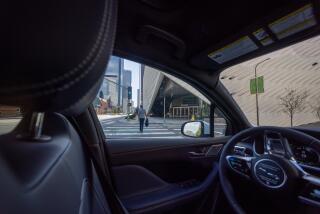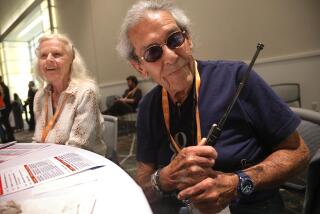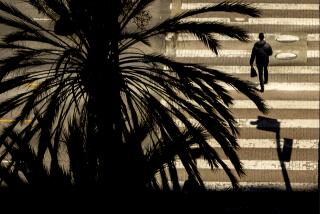Study of Streets, Signs Drives Home Ways to Make Life Safer for Pedestrians
NEW YORK — Every year in the United States, more than 5,000 pedestrians die in traffic accidents and more than 90,000 are injured.
Pedestrian accidents are common enough that they seem just the inevitable result of inattention, carelessness or plain bad luck.
After all, once you’ve provided traffic lights and crosswalks, and told people to be careful, what more can you do?
A lot, say experts who are investigating ways to make life safer for pedestrians.
Noting research in the United States and abroad, they cite an array of ideas, including better designs of streets and signs and teaching such tricks as the safest path for reaching the diagonal corner of an intersection.
“When we observe people walking and crossing streets, we see a tremendous number of errors” by both pedestrians and motorists, said Dan Burden of the Florida Department of Transportation. “So the eventual injuries are highly predictable in a society based on automobile travel, with neither one looking out for the other.”
One problem, ironically, is with the most visible part of pedestrian protection, the illuminated signs that say “Walk” and “Don’t Walk.”
The problem with “Walk” signs, experts say, is that people take them too literally. It’s the “starting-gun phenomenon,” said Richard Blomberg, president of the research firm Dunlap & Associates Inc. of Norwalk, Conn., which studies highway safety and other topics.
“Adults and children will stare at the signal and leave when it says ‘walk,’ ” rather than looking for cars that are turning into their path or running a red light, he said. “I can show you thousands of accidents” that resulted.
A flashing “Don’t Walk” sign poses problems too. Studies show most pedestrians do not understand what it means, Blomberg said, and that can be deadly.
Many think “they’re being told to get out of the street as fast as they can, so they run straight into the path of a motorist” who is turning right on red or completing a left-hand turn, Burden said.
Or they suddenly stop in the middle of the street or turn around and walk back toward their starting point, rather than continuing to walk forward as motorists are counting on them to do.
So a driver turning left or right “wipes out the pedestrian, thinking . . . they’re OK, that they’ve already watched that pedestrian (and now) all they have to do is look at the rest of the traffic,” Burden said.
For the record: A flashing “Don’t Walk” sign means not to enter the street. If you’re in the street already, you should have enough time to walk at a normal pace to the other side.
Studies of non-traditional pedestrian signals show some promise for reducing the hazard of misunderstandings, said Charles Zegeer, associate director of the University of North Carolina Highway Safety Research Center.
One experimental model told pedestrians to “Walk With Care” rather than just “Walk.” Tests in several cities found a marked reduction in incidents in which either the driver or the pedestrian had to take action to avoid a collision, Zegeer said.
Another experimental model, which replaced the flashing “Don’t Walk” sign with a signal saying, “Don’t Start,” also reduced such incidents at three of four test sites. Burden said he hopes to test that signal further in Florida.
Similar reductions appeared when researchers posted a sign for turning drivers that said, “Yield to Pedestrians,” or another for walkers that said, “Pedestrians Watch for Turning Vehicles.” Zegeer said such signs would have to be reserved for particularly hazardous intersections or they would be ignored.
Some European countries are using or exploring improvements for busy streets where pedestrians must push a button to get a signal to cross, he said.
One problem is that some people who push the button will not wait for the signal, but just dart across the street at the first apparent gap in traffic. Not only does that remove the protection from the signal, but it also stops traffic needlessly when the signal eventually comes on.
Some signposts in Britain respond to a button push with a lit-up sign that says, “Wait,” while others in Germany use a sign that says, “Wait for Signal,” Zegeer said. That acknowledgment, similar to seeing a light turn on after pushing an elevator button, encourages pedestrians to wait for the signal, Zegeer said.
Some European countries are also experimenting with infrared motion sensors to monitor a pedestrian’s progress after he or she pushes the button and gets a “Walk” signal. The sensors can keep traffic stopped until the pedestrian has reached the far curb, which helps the elderly or others who walk slowly. Preliminary studies suggest the sensors are workable and practical for areas with few pedestrians, Zegeer said.
Further testing of the experimental pedestrian signals and the European devices is needed to prove their usefulness before they could be adopted into national guidelines for use in the United States, Zegeer said.
Still other measures deal with street design. Florida now plans to install medians in future multilane arterial streets, Burden said. Medians let pedestrians deal with just one direction of traffic at a time and take some refuge in mid-crossing. Moreover, if they include a channel that angles the pedestrian to the right, they encourage pedestrians to face the traffic they must watch for in the second half of the trip, he said.
Of course, pedestrians themselves can make their lives safer.
For example, consider a pedestrian at an intersection of a couple of two-way streets who wants to end up on the far corner, diagonally across the intersection. The safest path is to cross each street so that the intersection is always on his right, Blomberg said. That way, during the especially dangerous first half of the crossing, the pedestrian is not exposed to vehicles that are leaving the intersection and speeding up, he said.
To increase visibility to drivers, pedestrians should travel in groups and, at night, carry a lit flashlight or wear reflective material that reflects headlight beams directly back at cars, experts say. Just wearing white at night doesn’t provide enough of a signal to drivers when traffic is moving faster than 35 m.p.h.
But researchers say the most important bit of advice to pedestrians is the traditional one: Stop at the curb and look left-right-left before entering the street, and train children to do the same. Blomberg found that animated films starring a character named “Willy Whistle” reduced accident rates in children.
“Pedestrians in general don’t make sufficient use of their eyes,” Blomberg said. “It’s not your feet that get you into trouble.”
More to Read
Sign up for Essential California
The most important California stories and recommendations in your inbox every morning.
You may occasionally receive promotional content from the Los Angeles Times.










